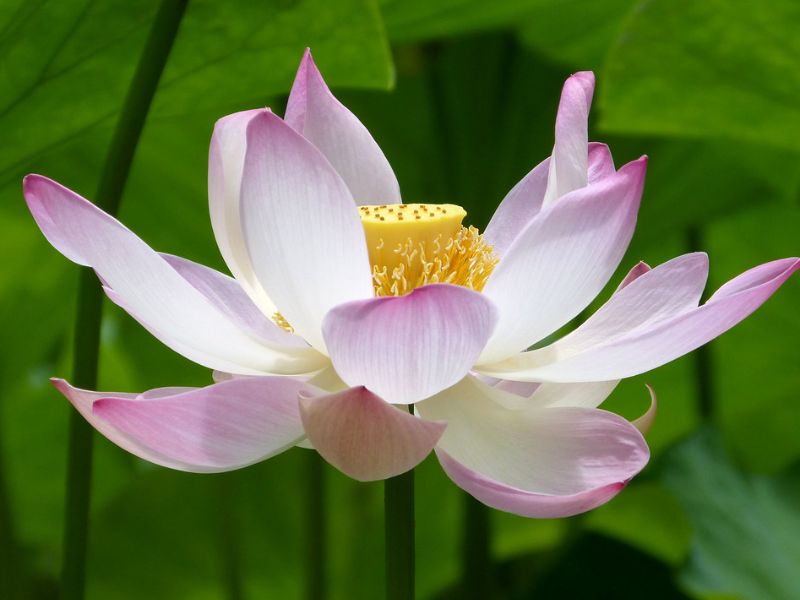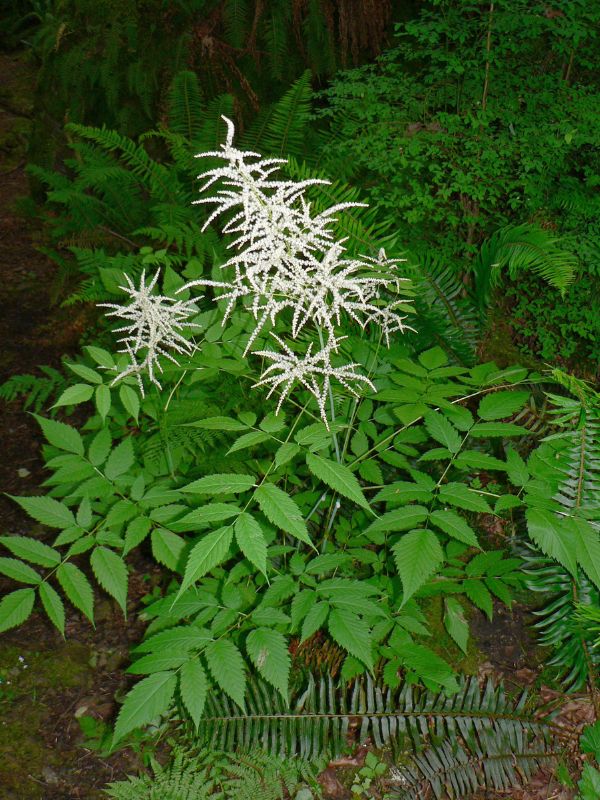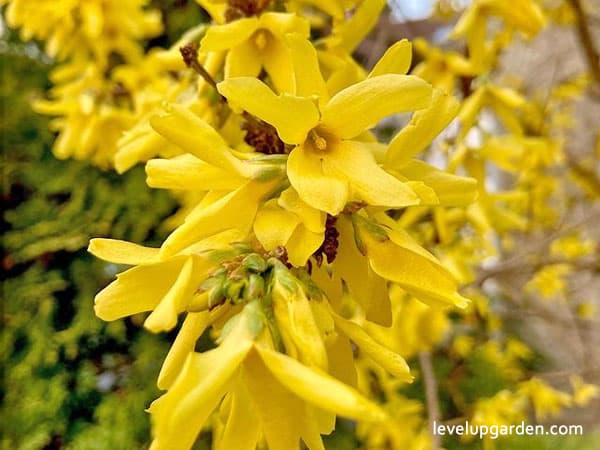Wisteria, also called Chinese Wisteria, is a flowering vine known for its beautiful purple flowers, native to China. It is a deciduous tree that is usually grown as a tree, but it also looks great on a trellis or shelf.
Imagine the sight of blue-purple flowers hanging from a bleak fence or wall. Wisteria trees are so spectacular because they produce so many fragrant flowers. Make sure your Wisteria tree is visible from your porch, deck, patio, or window. You will love to watch the butterflies flutter around the gorgeous, rich purple flower clusters.
This vine is considered invasive in the Southeast. It is a hardy vine, so it takes up a lot of space, needs sturdy supports, and must be in a sunny location for best blooms. In spring, fragrant, blue-purple, pea-shaped flowers on 6 to 12 inch stems bloom almost simultaneously, creating a very spectacular display. After flowering, velvety seed pods hang down and remain until fall.
It grows in moist or dry areas and forms very dense thickets. This invasive vine entangles trees and shrubs, covering them, and crowding them by runners that germinate from the nodes. Regular pruning is necessary to keep the tree in shape and prevent overgrowth and invasion. The stems twist over time, becoming trunk-like and enormous. Use mildly acidic soil for best growth results.

Wisteria tree may take time to establish. Its flowers may not appear until the second or third year after planting and may be longer. But, pruning the roots in the fall may help produce more flowers the following spring.
Unlike the Japanese Wisteria, this tree has a counterclockwise twining habit, fewer leaves, shorter flower clusters, and a somewhat weaker fragrance. This tree has everything one could want in a plant. Wisteria trees are easy to grow, they can adapt to a wide variety of soils, and are not only drought and deer resistant, but also disease resistant.
Wisteria is a deciduous perennial vine. Like other members of the Wisteria family, it produces magnificent flowers, but unfortunately it is toxic and very invasive. But it is large, fragrant, and grows in a drooping cluster, usually blue-purple in color; they bloom from May to June.
It is best planted in spring or fall. This is a vigorous growing vine, reaching up to 25 feet tall. The trellis or other support needs to be sturdy enough to withstand the weight of the plant. Wisteria grows quickly and can take up to 20 years to flower and also tends to live very long.
I. Plant Profile – An Overview of the plant
The sweet-scented Wisteria is a large, deciduous tree with twining stems, prized by gardeners for its vigor, beauty, and sweet fragrance. In late spring, before the foliage, fragrant pea-like mauve flowers bloom in drooping clusters up to 30 cm long.
The dramatic floral display is caused by its simultaneous bloom. The flowers are followed by attractive, velvety, bean-like pods up to 15 cm long that ripen in the fall and may persist into the winter. The leaves are dark green and composed of 7 to 13 lobes, up to 7 cm long.
| Common names | Chinese Wisteria, Wisteria, Chinese Kidney Bean, Fabables, Vilmorin |
| Botanical name | Wisteria sinensis |
| Family | Fabaceae |
| Plant Type | Deciduous perennial vine |
| Sun | Full sun to partial sun |
| Soil Type | Medium moist, well-draining |
| Soil pH | 6.0 – 7.0 (slightly acidic to neutral) |
| Bloom Time | May to June |
| Flower Color | Bluish-purple, mauve, white |
| Growth Rate | Moderate |
| Type | Vine |
| Family | Fabaceae |
| Zone | 5 to 8 |
| Height | 10 – 25.00 feet |
| Spread | 4 – 8.00 feet |
| Bloom Description | Blue violet |
| Water | Medium |
| Maintenance | High |
| Toxicity | Toxic to dogs, toxic to cats, toxic to horses. |
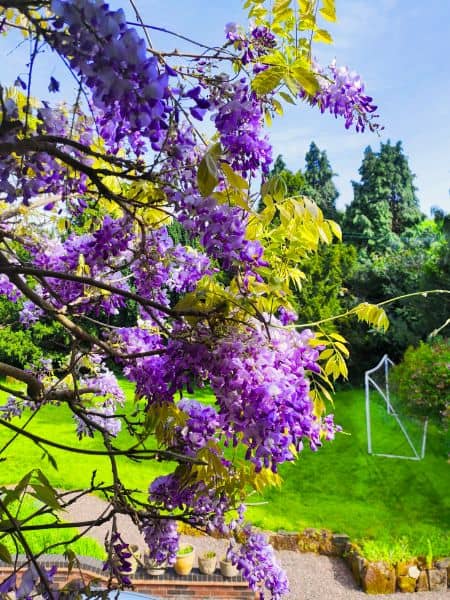
II. Appearance
Wisteria Tree is a deciduous vine that grows vigorously to 25 feet or more and produces 6 to 12 inch long racemes of mildly fragrant, pea-like, blue-purple flowers in May when the leaves begin to elongate. The flowers bloom simultaneously on racemes, creating a dramatic floral display. After flowering, velvety bean-like seed pods form, ripen in fall, and persist through winter.
It produces single, less fragrant flowers that bloom simultaneously. Its flowers are white, purple, or blue, borne in 15 to 20 cm inflorescences in spring before the leaves emerge. The stem twists over time, becoming trunk-like and enormous.
The stems intertwine counterclockwise, clinging to plants and artifacts. The leaves are glossy green, pinnate compounds, 10 to 30 cm long, composed of 9 to 13 oblong lobes, each has a length of 2 to 6 cm.
The flowers open all at once before the leaves unfurl and give off a distinctive grape-like fragrance. The petals are shorter than those of the Wisteria hakama, but there are more petals. The fruit is a flattened, brown velvety bean-like pod 5 to 10 cm long with thick disk-shaped seeds around 1 cm in diameter evenly spaced inside. However, seed production is often low and most regenerative growth occurs by stratification and suckering.
III. Growing and Care Conditions
Wisteria tree is best grown in sunny, slightly acidic, humusy, moderately fertile, medium moisture, well-drained soils. It requires full sun for best flowering. It has vigorous growth and rooting surface runners. This vine requires space and sturdy supports for growth.
However, this tree may take time to establish. It may flower in the second or third year after planting, but may take longer, up to 15 years. Those grown from seed can take up to 20 years to flower.
For Wisteria Tree, periodic pruning is necessary to improve the size and shape of the plant and to encourage flowering, such as cutting back the stems after flowering in early summer and in winter. Late fall root pruning may also encourage flowering the following spring. Improper pruning may encourage excessive plant growth and sacrifice flowering.
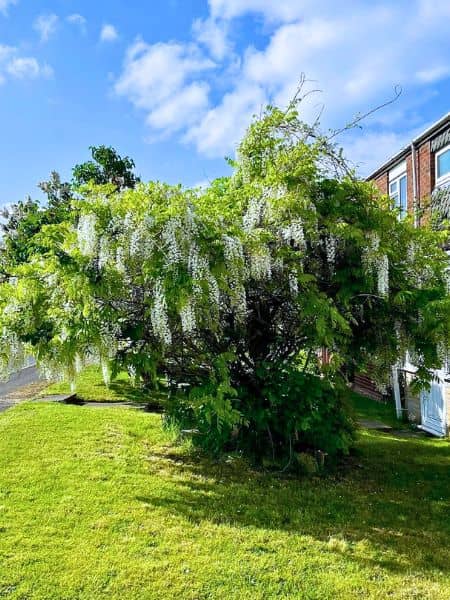
For more information on initial growth and pruning of vines, refer to the pruning guide. Also, spraying with superphosphate in early spring can promote flowering. Make sure to choose planting sites carefully, as these plants do not like to be replanted.
Planting
Plant Wisteria in spring or fall, while the land is dormant. To plant the Wisteria Tree, dig a hole as deep as the root ball and twice or thrice as the width. However, you need to make sure there is space between the plants of about 10 to 15 feet.
Light
For best results, choose a sunny location. Wisteria trees will grow in the shade, but will not produce flowers. Remember that it needs full sun to grow properly.
Watering
Water deeply once or twice a week. Purple Wisteria is quite drought tolerant and once established will grow with only rainfall.
Fertilizer
Wisteria trees do not need fertilizer unless the soil is thin and barren. But, too much nitrogen can be harmful. Apply a compound fertilizer with high phosphorus content only once a year. To improve poor soil, add compost to promote growth and flowering.
Soil Requirements
It prefer humus-rich, moderately fertile, slightly acidic soil. Good drainage of soil is important. They do not like to be transplanted, so make sure the soil is suitable for the planting site.
Temperature
Wisteria can tolerate freezing temperatures, but persistent cold can cause bud dieback and poor flowering. It prefers high humidity, but will grow in dry areas as long as the soil is moist.
Pruning
To encourage growth of the main trunk, promptly cut off any branches that are not growing from the base. As the tree grows, remove lower shoots to maintain a tree shape in which all growth takes place at the top. The tree should also be pruned regularly to prevent the top of the tree from becoming too heavy. Pruning should be done in early spring.
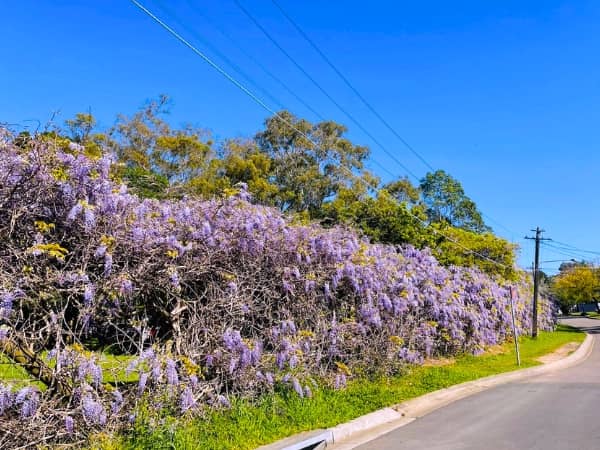
Pollination
Wisteria flowers are early bloomers, blooming from April to May. The flowers are sweetly fragrant and reminiscent of grapes. Hummingbirds and bees are often seen visiting the violet flowers in spring, spreading their pollen to other Wisteria trees.
The invasive nature of Wisteria trees is due to the vigorous spread of the stolons. The flowers and pods are toxic to humans and pets. You can put signs near the plant to warn onlookers.
Pests and Diseases
The Wisteria Tree is susceptible to leaf-eating insects and fungal diseases, but there are no major diseases. However, it is considered a high maintenance plant because it requires regular pruning, and is invasive. Its flower buds are easily damaged by early spring frosts.
The possible causes of non-flowering include flower buds dying in winter, too much shade, seedlings too young (especially seedlings sown from seed), improper pruning, and over-fertilization. Alkaline soils can cause yellowing of leaves. Perform a soil test to check soil pH levels. If the pH level is too high, add elemental sulfur, aluminum sulfate, or sulfuric acid to increase acidity levels.
Wisteria leaves naturally turn yellow in autumn when the temperature drops. However, even at other times of the year, leaves may become limp and yellow and begin to fall from the plant if the soil is excessively moist and humid. Check soil drainage and discontinue watering until soil drainage problems are resolved.
If the leaves form mottled discoloration, they may be infected with a rare disease called mosaic virus. This virus has no cure and will spread throughout the plant. Infected vines should be removed and disposed of immediately.
IV. Varieties
Wisteria sinensis “JaKo”, this award-winning deciduous vine is favored for its pea-white, fragrant flowers.
Japanese Wisteria (Wisteria floribunda), similar to the Chinese Wisteria, but an Asian species that invaded North America. The flowers are more showy and require more sun.
Prolific (Wisteria sinensis ‘Prolific’), is sweetly fragrant, blue-purple flower clusters grow to a foot long and bloom in profusion during the summer months.
American Wisteria (Wisteria frutescens), although Smaller than Japanese and Chinese Wisteria, matures earlier than the Asian species and flowers when young. It is also not as aggressive as the non-native Chinese Wisteria.
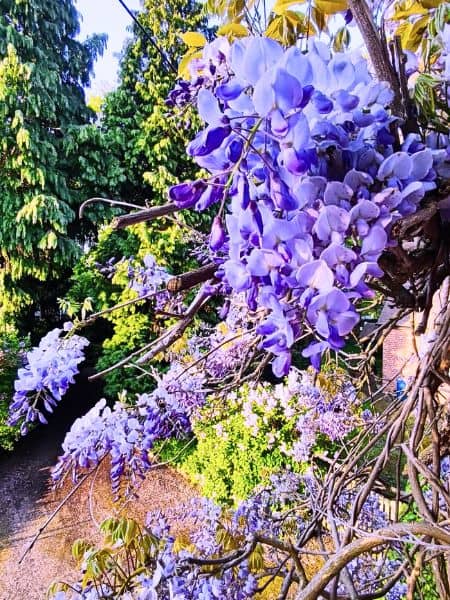
V. Uses
Due to the invasiveness of the Wisteria Tree, you should plan ahead when planting this tree. It should only be planted and tailored to a sturdy structure that can support the weight of the mature vines. This plant is ideal for large, sturdy, free standing arbors, pergolas, posts, trellises, fences, and patio walls.
It also works especially well when planted near or on a patio where you can enjoy seasonal flowers. It can also be grown as a specimen shrub or tall tree.
VI. Why should you buy this plant
Unlike other Wisteria varieties, this unique Wisteria tree delivers your favorite color and whimsical flowers in a more manageable size. While Wisteria is known for growing huge in warm southern climates, this lavender beauty can be owned by anyone in tree form. Even so, its unique lavender-colored flowers can be enjoyed almost anywhere. From April through June each year, fragrant violet-blue flowers cover the Wisteria tree, their delicate blooms drooping down the branches like a chandelier and blooming in your yard.
Importantly, Wisteria trees take care of themselves almost exclusively. Deer and drought resistant, they are virtually impervious to disease and pests, so there is no need to spray them with harmful chemicals or leave them in the garden for hours on end. It is a vigorous growing tree and thrives in both sun and shade.
The Wisteria is unique in form, this compact tree is about 10-15 feet tall and wide at maturity, making it ideal for most landscapes. It produces a very large number of flowers, which are wonderful and long lasting. It blooms continuously from spring to early summer.
It should be noted that it has a wonderful blue-purple color. Depending on the environment, the color can change subtly from bluish to purplish, but this variety always has at least a bluish tint, making it a very attractive color. Wisteria Tree is easy to maintain, adaptable, and fast-growing, and is a hardy plant. It is also drought tolerant and resistant to deer and disease. It attracts butterflies and hummingbirds.
VI. FAQs
How long does it take to grow a Wisteria tree?
Wisteria trees grow slowly and may not flower until 3 to 5 years after planting. Wisteria trees are fast growing and can grow to a height of over 3 meters in one growing season. It is good for quickly covering a fence or pergola, but you don’t want the vines to cover the entire garden.
Do Wisteria trees smell good?
Wisteria, known for its fast growth, produces large flowers, but they do not have a strong fragrance and come in pretty shades of purple and lavender.
How big do Wisteria trees get?
They are drought tolerant and can grow to a height of 15 to 40 feet in partial shade or full sun. However, it will always produce its most spectacular blooms when grown in moist soil and full sun.
What month does Wisteria bloom?
Wisteria is a well-rewarded plant, blooming beautifully between April and June, sometimes with a second flush in August. Wisteria is native to Japan and comes in two types: floribunda, which grows in a clockwise direction, and chinensis, which is native to China.
